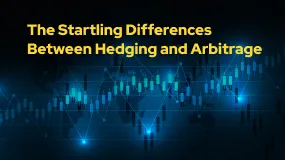简体中文
繁體中文
English
Pусский
日本語
ภาษาไทย
Tiếng Việt
Bahasa Indonesia
Español
हिन्दी
Filippiiniläinen
Français
Deutsch
Português
Türkçe
한국어
العربية
Will the Fed Cut Rates in 2025? What to Expect
Abstract:The Federal Reserve has implemented multiple interest rate cuts in 2024, bringing the rate to a range of 4.25%-4.5% by the end of the year. However, whether the Fed will continue cutting rates or shift to rate hikes in 2025 remains uncertain. The Fed's policy direction depends not only on economic data but also on internal adjustments, the policy direction of the new president, and other factors.

In January 2025, a new U.S. president will take office, and the policy changes of the incoming administration could influence the Fed's monetary policy. The policies of the Trump administration, particularly regarding trade and fiscal policy, could introduce new uncertainties. These policies might affect inflation expectations and economic growth momentum. Such external factors could prompt the Fed to reassess its monetary strategy.
In 2023 and 2024, the U.S. faced relatively high inflation, especially driven by rising food and energy prices. However, with the Fed's aggressive rate hikes and improvements in global supply chains, inflation has started to ease. If inflation continues to stay low in 2025, and economic growth slows or the labor market weakens, the Fed may opt to continue cutting rates.
U.S. economic growth will directly impact the Feds policy decisions. The Fed's aggressive rate hikes in the past year were aimed at curbing inflation, with the goal of achieving an economic “soft landing” — controlling inflation without triggering a recession. If by 2025, the Fed believes inflation is under control and economic growth has slowed, it might implement rate cuts to prevent excessive economic stagnation or a recession.
Moreover, global economic changes could also influence the Fed's decisions. If global economic growth weakens, particularly if major economies like the Eurozone or China enter recession, the U.S. might face greater external pressure. To cope with global uncertainties and stimulate domestic demand, the Fed could opt for rate cuts to maintain the competitiveness and vitality of the U.S. economy.
The health of the U.S. labor market is another key factor. If the unemployment rate remains low and wage growth does not spiral out of control, the economy may continue to grow healthily, and the Fed may choose to keep interest rates unchanged or make modest adjustments. On the other hand, if unemployment rises, the Fed might cut rates to stimulate job growth.
In addition to economic data, the Fed's policy direction will also be influenced by statements from Fed officials and internal adjustments. Markets generally expect the Fed‘s rate-cutting process to be slower and more cautious. Goldman Sachs’ chief economist Jan Hatzius pointed out that Fed Chairman Jerome Powells December 2024 remarks strongly signaled that rate cuts are unlikely at the beginning of 2025, and that more data will drive policy decisions. Furthermore, with new voting members joining the Fed's Federal Open Market Committee (FOMC) in 2025, the committee may experience more internal divisions, which could affect future policy direction.
Apart from domestic factors, changes in the global economic environment could also influence the Feds decisions. For instance, if the global economy weakens or if major economies like China or the Eurozone enter recession, the U.S. may face external pressures, prompting the Fed to adopt a more accommodative policy to stimulate economic growth.
In summary, the likelihood of the Fed continuing to cut rates in 2025 seems relatively high, especially if U.S. economic growth slows and inflation is effectively controlled. However, nothing is certain. If the Fed believes the economy still needs support, or if inflation has not been fully tamed, the rate-cutting pace could be more cautious. Investors will need to closely monitor economic data, the labor market, global economic developments, and the statements from Fed officials to better predict the future direction of U.S. monetary policy.

Disclaimer:
The views in this article only represent the author's personal views, and do not constitute investment advice on this platform. This platform does not guarantee the accuracy, completeness and timeliness of the information in the article, and will not be liable for any loss caused by the use of or reliance on the information in the article.
Read more

FSMA Warns That Some Firms Operate as Pyramid Schemes
The FSMA has sounded the alarm on a “new wave of fraudulent trading platforms” that rely on pyramid schemes to sustain payouts. According to regulator observations, these schemes allow small withdrawals at first in order to build trust, then use excuses to block larger withdrawal attempts. Eventually, when recruitment of new participants falters, the platform vanishes with all funds, leaving victims empty‑handed.

FortuixAgent Review: What You Should Know?
FortuixAgent is an automated trading platform designed to execute buy and sell orders by leveraging live market data and artificial intelligence. The platform supports multiple asset classes, including forex majors, crypto pairs, and precious metals, allowing diversification from a single dashboard. Recently, FortuixAgent has played a role in many regional markets, including South Africa, South Asia, etc. However, is it reliable?

Is Your Forex Strategy Failing? Here’s When to Change
Have you been encountering frequent forex losses? Finding it hard to gain the trading momentum? Can’t understand whether your current forex strategy is in line with the shift in economic indicators or the geopolitical climate? Overcomoming these will require a change to your forex investment strategy. Learn those smart strategic changes here.

The Startling Differences Between Hedging and Arbitrage
The two risk management investment tools - hedging vs arbitrage - have been helping investors achieve their respective financial goals. Explore this comparision to understand their functionalities, the investment purpose they serve, the risk attached, and several other aspects.
WikiFX Broker
Latest News
Is Your Forex Strategy Failing? Here’s When to Change
FSMA Warns That Some Firms Operate as Pyramid Schemes
Apex Trader Funding is an Unregulated Firm | You Must Know the Risks
Sigma-One Capital Scam? Investors Say They Can’t Withdraw Funds
Federal Reserve likely to hold interest rates steady despite pressure from Trump. Here's what that means for your money
WEEKLY SCAM BROKERS LIST IS OUT! Check it now
Intel drops 9% as chipmaker's foundry business axes projects, struggles to find customers
Palantir joins list of 20 most valuable U.S. companies, with stock more than doubling in 2025
Textiles to whisky: U.K.–India 'historic' deal is set to boost bilateral trade by over $34 billion a year
Thailand-Cambodia border clashes: Cambodia's economy has more to lose, analysts say
Currency Calculator


